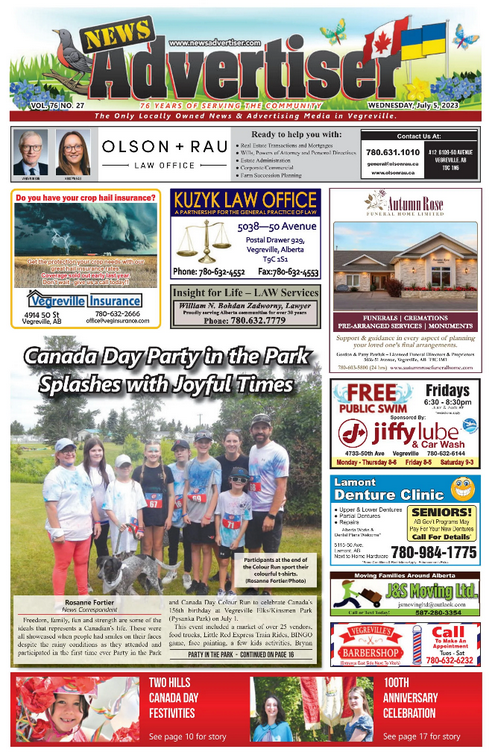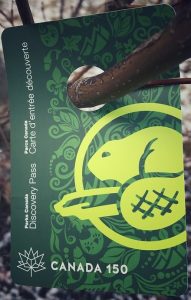9.2 Promotion
Whenever we design a program or event, to get people to attend or engage in it, we need to attract their interest. When an organization or agency engages in organized publicity activities, they increase the visibility of information to the general public, thereby peaking interest and enticing, encouraging or even persuading people to attend. There are four main ways in which programmers can promote recreation programs and events: advertising, publicity, personal sales, and promotion.
1. Advertising
Advertising is any form of paid communication used to call the attention of the public to a program, event, product, service or organization. Advertising can take many forms, such as:
Dedicated space in a newspaper or flier
Example: Canada Day party ad

An ad in a print magazine or Ezine
Example: Advertisement for McConks inflatable kayaks and SUPs (Stand Up Paddleboards)

Flyers
Example: A flyer advertising the availability of financial assistance for the Y of Southwestern Ontario’s Youth Recreation and Sports program, as found in the Zurich Minor Hockey Association’s website:

Outdoor Media Advertising
Example: Bus signage advertising Whitman Park.

Other types of outdoor media advertising include billboards, park benches, etc.
Instagram Reel
Example: A sampling of Instagram posts and reels promoting different events from the 2021 ‘Fit-For-Care Wellness Week’ fundraiser for McCormick Care Group.
![]()
Food for Thought…
In this quickly evolving digital age, many of the print ads historically seen in industry journals, magazines and newspapers, and those received through the postal system, have now made way for digital mobile ads in the form of short-form video content, such as Instagram reels and YouTube shorts.
2. Publicity
Publicity usually comprises just a small piece of an agency or organization’s overall marketing plan for a program or event. Publicity is any form of unpaid communication that influences an impression held by others, shaped by the media or public in some way. Examples of publicity can include:
- Word of mouth/ Customer Referrals: One person telling another they should sign up for a program, catch that play, enroll in this program, etc. based on their personal experience.
- Personal Social Media: Posting an unpaid like, comment, review, reel or other type of post on social media is a form of publicity. Example: Someone might respond to an advertised event on Facebook, saying, “Ooo! Got my tickets today! Can’t wait!”, then share the event to their personal page or account. This is a form of publicity. Note: As the message hasn’t been specifically designed by a professional agency or business, it is often controlled by the public and the media rather than the agency itself.
- Press Release: A press release is an official statement delivered specifically to the media for the purpose of providing information or making an announcement. For example, this press release announcing the grand opening of a new Community Recreation Centre in Toronto:

Image Description
The City of Toronto celebrates the grand opening of the Ethennonnhawahstihnen Community Recreation Centre and Library.
News Release, March 23, 2024
Today, Mayor Olivia Chow was joined by Councillor Shelley Carroll (Don Valley North), Cheif William Romain from the Huron-Wendat Nation, Elder Valarie King from the Mississaugas of the Credit First Nation, Cheif Sherri-Lyn Hill from the Six Nations of the Grand River and other distinguished guests to officially open the Ethennonnhawahstihnen’ Community Recreation Centre and Library.
A significant name and location
The name Ethennonnhawahstihnen’ (pronounced Etta-nonna wasti-nuh), meaning “where they had a good, beautiful life, “was a gift from the Huron-Wendat Nation to the City of Toronto.
The community centre is located near Bayview and Sheppard Avenues in North York and is within 800 metres of a significant Huron-Wendat archaeological site, the Moatfield Ossuary and village, where findings show that inhabitants lived long and healthy lives in relative peace.
3. Sales Promotions
A sales promotion is a marketing activity designed by an agency with the intention of stimulating interest and engagement in their organization, brand, a specific activity, or a program. In recreation, promotions often come in the form of incentives – something that encourages someone to do something – like rebates, discounts, coupons, contests, samples, free merchandise, and 2-for-1 memberships. More often than not, promotions are offered for a limited time only, effectively creating a sense of urgency for the consumer to get on board!

![]()
Example
To celebrate Canada’s 150th anniversary, Parks Canada offered a special promotion. The organization granted free access for every citizen to every one of its 38 National Parks through a “Discover Pass”, available free of charge through the Parks Canada website, for all of 2017. The promotional campaign was designed to promote increased interest and engagement in Canada’s Parks, and it worked! According to Parks Canada, their website was almost overwhelmed when more than 900,000 people ordered a free Discovery Pass in the first two weeks after it became available (Canadian Press, 2017). “On Dec. 1, so many people jumped online to get a free annual pass that the department’s computer system slowed to a crawl” (Canadian Press, 2017).
Digital and Social Media
In recent years, the marketing and promotion of recreation programs have undergone a significant transformation due to the rise of social media. Traditional methods like flyers and newspaper ads have taken a backseat to digital strategies leveraging platforms such as Facebook, Instagram, and TikTok. These platforms offer unparalleled reach and targeting options, allowing recreation programs to engage directly with their target demographics. One notable trend is the emphasis on user-generated content. Recreation programs encourage participants to share their experiences on social media, effectively turning them into brand ambassadors. This word-of-mouth marketing can be incredibly powerful in building trust and credibility. In the age of social media, when Likes, Follows, and positive Google ratings and reviews are of paramount importance, potential recreation participants are just a simple Internet search away from hearing and reading what others have to say about a given recreation program or agency. To this end, the recreation and leisure industry has been quick to adapt, leveraging positive participant experiences into sound bites, reels and videos designed to entice non-participants to sign up and join in.
Storytelling has become a cornerstone of marketing strategies for recreation programs. Recreation organizations across sectors use social media to tell compelling stories about their activities and the impact they have on participants’ lives, creating emotional connections that resonate with their audience. In the video below, Outward Bound Canada expedition participant Isabelle shares her 3-week experience traversing Algonquin Park by canoe, a powerful promotional testimonial that urges people considering registering from an Outward Bound program to “Go for it!”
Video: “Algonquin Summer: Isabelle’s Story” by Outward Bound Canada [3:51]. Transcript and closed captions available on YouTube.
Issues with Digital and Social Media Promotion Strategies
The evolution of marketing and promotion strategies in recreation programs underscores the importance of embracing social media as a powerful tool for reaching and engaging with audiences in today’s digital landscape. However, marketing recreation programs and events in a digital age is not without its challenges. Scianas (n.d.) indicates there is a “digital divide” in Canada, separating those with access to technology from those who do not. According to Sciandas (n.d.), contributing factors to the “haves” and “have-nots” (p.2) include differing literacy levels, incomes, education and financial resources (pp.2-3). Additionally, members of certain populations, like the elderly or those with specific cognitive disabilities, for example, may have limited access to or understanding of digital technologies. Thus, if only digital tools are used in the marketing and promotion of a program, agencies run the real risk of excluding some populations and their efforts not reaching their target audience.
Another drawback to advertising or promoting on digital- and social media-based channels is the general lack of control an organization has over the content of online responses in the form of program or agency reviews, videos, photos and comments. It doesn’t take many 1-star reviews and critical comments to diminish the appeal of a recreation-based program or agency to the public. The right to freedom of expression is alive and well in Canada, but as It is not always possible to control what others post on social media, if the material posted casts a recreation program, event or agency in a negative light, the organization may find it hard to attract future participants or customers.
4. Public Relations (PR)
Public Relations (PR) refers to strategic ways in which an organization shares information with the public in order to keep the organization in a positive light. The goal of PR is to positively influence public perception toward the organization, its programs, and the people who work there.
PR is highly relationship-focused. “Good PR” (positive public perception) is based on trust and can take time to develop. Good PR tends to be built on relationships with the agency’s stakeholders and constituents in ways that create win-wins. Organizations concerned with generating Good PR take care to communicate and share specific stories about the people of the organization or the organization itself in ways that uphold a favourable public image.
Recreation organizations across all sectors know that maintaining a healthy image and state of the relationship between themselves and the public is vital to retaining clients (and attracting new ones!). Therefore, staff and personnel – from unpaid volunteers to senior management – are often highly intentional and careful about creating narratives and spinning stories about their organization or a specific program to ensure the agency is cast in a positive light in the eyes of the public.
“Good PR”: Any messaging or information about an organization communicated to the public that casts the organization in a positive light or promotes goodwill with the public, helping them build their reputation and image. For example, photo opportunities with influencers or community leaders, publicly making a donation to a charity, and having a team from the organization participate in a fundraiser for a good cause.
“Bad PR”: Any messaging or information about an organization communicated to the public that reflects poorly on the organization, with the potential of having a negative impact on reputation and image. Examples include a Senior Manager being charged with a crime, bad reviews on social media, the public discovering a controversial comment or post from an agency representative on social media, and a clumsy response to a crisis.
![]()
Section Summary
Marketing is a broad umbrella term that encompasses any activities aimed at positively promoting products or services to the public, like Publicity, Promotion, and Public Relations.
Publicity focuses on generating media attention and coverage for an organization or its goods and services through unpaid channels like news stories, interviews, or reviews.
Promotion involves the use of various tactics to entice and encourage public participation, such as discounts, contests, coupons or samples.
Public relations (PR) is the art of managing the reputation of an organization or individual through its communications and relationships with the public. While each element serves distinct purposes, they often intersect, overlap, and work together collaboratively to achieve an agency’s program marketing goals while maintaining an agency or organization’s positive image.
Before diving into promotional activities, program-planners need to consider their program or event’s goals & objectives, their target audience (who they are trying to reach), their budget (how much promotion can you afford?), and ultimately the nature of the program or event they are planning to promote, as not all marketing strategies are suitable for all programs.
OpenAI. (2024, April 29). ChatGPT. [Large language model]. https://chat.openai.com/chat
Some sections (First six sentences of Digital and Social Media and first sentence of Issues with Digital and Social Media Promotion Strategies) were created with ChatGPT using the prompt “Discuss trends in the marketing and promotion of recreation programs as they relate to the rise of social media and how marketing and promotion techniques have evolved over the past few years.”


